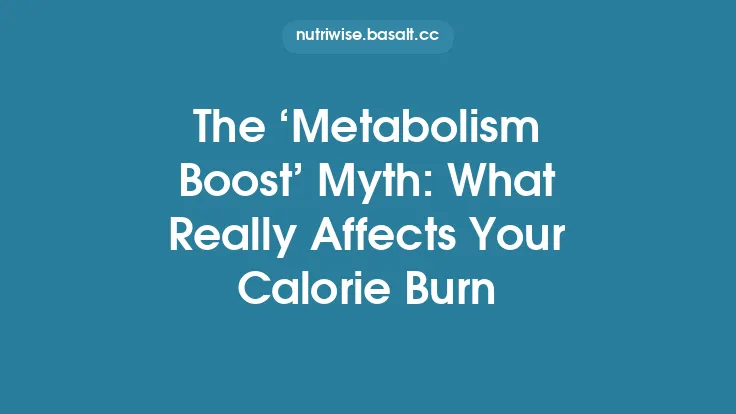Weight loss is rarely a straight line. Most people who embark on a calorie‑controlled or lifestyle‑focused journey notice rapid changes at the start, followed by a period where the numbers on the scale seem to stall. This “plateau” is often blamed on a lack of willpower or a broken diet, but the reality is far more nuanced. Below we unpack the physiological, hormonal, and behavioral mechanisms that cause weight‑loss velocity to decelerate, and we outline evidence‑based tactics for navigating this inevitable phase.
What Is a Weight‑Loss Plateau?
A weight‑loss plateau refers to a temporary cessation or marked slowdown in the reduction of body mass despite continued adherence to the same dietary and exercise regimen that previously produced results. It is not a permanent halt; rather, it is a normal adaptive response that can last anywhere from a few days to several weeks, depending on individual factors such as genetics, body composition, and the magnitude of the initial caloric deficit.
Key characteristics of a plateau include:
- Stable body weight (±0.5 kg or 1 lb) over a period of at least 2–3 weeks.
- Consistent adherence to the same macronutrient distribution, meal timing, and training program.
- No major changes in external variables (e.g., illness, medication, major stressors).
Understanding that a plateau is a physiological signal rather than a personal failure reframes the experience from a moral judgment to a data point that can be strategically addressed.
Physiological Reasons for Slowing Weight Loss
1. Adaptive Thermogenesis
When energy intake is reduced, the body initiates a cascade of metabolic adjustments collectively known as adaptive thermogenesis. This process reduces the amount of energy expended at rest (resting metabolic rate, RMR) and during activity, effectively narrowing the caloric gap that drives weight loss.
- Reduced RMR: Studies have shown that a 10–20 % decrease in RMR can occur within weeks of initiating a moderate caloric deficit. This is partly due to loss of metabolically active tissue (lean mass) and partly due to hormonal shifts that down‑regulate thyroid hormone activity.
- Decreased Non‑Exercise Activity Thermogenesis (NEAT): Subconscious movements—fidgeting, posture adjustments, and spontaneous walking—tend to decline when the body perceives an energy shortage, further curbing total daily energy expenditure.
2. Loss of Lean Body Mass
While the primary goal of most weight‑loss programs is fat reduction, a proportion of the weight lost inevitably comes from lean tissue (muscle, organ mass, bone). Since lean mass is more metabolically active than adipose tissue (approximately 13 kcal/kg/day vs. 4.5 kcal/kg/day), its reduction directly lowers the baseline caloric burn.
- Muscle atrophy: Even with resistance training, a modest caloric deficit can lead to a net loss of muscle protein if protein intake and stimulus are insufficient.
- Organ mass: The liver, kidneys, and heart also shrink slightly during prolonged energy restriction, contributing to a lower RMR.
3. Energy Efficiency Improvements
The body becomes more efficient at performing the same physical tasks with less energy. For example, repeated bouts of the same cardio routine can lead to a lower oxygen cost per kilometer, meaning fewer calories are burned for the same distance.
Hormonal Shifts That Influence the Scale
Weight‑loss plateaus are closely tied to changes in several key hormones that regulate appetite, satiety, and energy expenditure.
| Hormone | Typical Change During a Deficit | Effect on Weight Loss |
|---|---|---|
| Leptin | Decreases | Reduces satiety signaling, potentially increasing hunger |
| Ghrelin | Increases | Stimulates appetite, making adherence more challenging |
| Thyroid Hormones (T3/T4) | Decrease | Lowers basal metabolic rate |
| Insulin | Decreases (improved sensitivity) | May aid fat mobilization but also signals the body to conserve energy |
| Cortisol | May rise with chronic stress or inadequate recovery | Promotes gluconeogenesis and can favor visceral fat storage |
These hormonal adaptations are evolutionary safeguards designed to protect against prolonged starvation. Recognizing their role helps explain why cravings intensify and why the scale may stall even when the diet remains unchanged.
Changes in Body Composition and Energy Expenditure
Fat‑Free Mass vs. Fat Mass
As fat mass diminishes, the proportion of total body weight represented by fat‑free mass rises. Since fat tissue is less metabolically active, the overall energy cost of moving a lighter body can actually decrease, offsetting some of the caloric deficit.
Water Balance
Weight‑loss interventions often cause rapid shifts in extracellular and intracellular water. Early losses are frequently water‑related, while later phases reflect true tissue loss. Fluctuations in glycogen stores (each gram of glycogen binds ~3 g of water) can cause day‑to‑day weight variability that mimics a plateau.
Behavioral and Lifestyle Factors
1. Subtle Increases in Energy Intake
Even meticulous tracking can miss small, cumulative additions—extra teaspoons of oil, a handful of nuts, or “cheat” meals that are larger than intended. Over time, these can erode the caloric deficit enough to halt progress.
2. Diminished Exercise Intensity
When weight drops, the same absolute workload feels easier, leading many individuals to unconsciously reduce effort (e.g., slower pace, fewer intervals). Without adjusting intensity or volume, the caloric burn from exercise declines.
3. Sleep and Stress
Insufficient sleep (≤ 6 h) and chronic psychosocial stress elevate cortisol and ghrelin, both of which can blunt weight loss. Moreover, sleep deprivation reduces growth hormone secretion, impairing muscle preservation.
4. Nutrient Timing and Meal Frequency
While not directly linked to the “plateau myth,” the timing of protein intake and the distribution of meals can influence muscle protein synthesis and satiety, indirectly affecting the ability to maintain a deficit.
How to Distinguish a True Plateau from Normal Variability
- Track Trends, Not Single Data Points
Use a rolling average (e.g., 7‑day or 14‑day) to smooth out daily fluctuations caused by water balance, bowel movements, and hormonal cycles.
- Measure Multiple Indicators
- Body composition (via bioelectrical impedance, DEXA, or skinfolds)
- Circumference measurements (waist, hips, thighs)
- Performance metrics (strength, endurance)
If fat loss continues despite a stable weight, the plateau may be superficial.
- Assess Adherence Objectively
Re‑evaluate food logs, portion sizes, and training logs for hidden caloric creep or reduced intensity.
- Consider Time Frame
A plateau lasting less than two weeks is often within normal physiological noise. Persistent stagnation beyond four weeks warrants a strategic review.
Evidence‑Based Strategies to Overcome a Plateau
| Strategy | Rationale | Practical Implementation |
|---|---|---|
| Re‑calculate Energy Needs | RMR declines as weight drops; the original deficit may now be smaller. | Use a validated equation (e.g., Mifflin‑St Jeor) with current weight, then subtract 15–20 % for a new deficit. |
| Increase Protein Intake | Preserves lean mass, supports thermogenesis via the thermic effect of protein (≈ 20–30 % of calories). | Aim for 1.6–2.2 g/kg of body weight per day, distributed across meals. |
| Incorporate Resistance Training | Stimulates muscle protein synthesis, mitigates loss of lean mass, raises RMR. | 2–4 sessions/week focusing on major muscle groups, progressive overload. |
| Add High‑Intensity Interval Training (HIIT) | Elevates post‑exercise oxygen consumption (EPOC), improves metabolic flexibility. | 1–2 sessions/week, 10–20 min total work, 30 s high effort/30 s rest. |
| Manipulate Training Variables | Prevents the body from becoming efficient at a single stimulus. | Change exercise modality, increase load, alter rep schemes, or add plyometrics. |
| Prioritize Sleep Hygiene | Improves leptin/ghrelin balance, supports recovery. | 7–9 h/night, consistent bedtime, limit screens before sleep. |
| Stress Management Techniques | Lowers cortisol, reduces emotional eating. | Mindfulness meditation, yoga, breathing exercises, scheduled leisure. |
| Re‑feed or Diet Break | Short‑term increase in calories (especially carbs) can temporarily raise leptin, boost RMR, and improve adherence. | 1–2 days of maintenance calories, focusing on nutrient‑dense foods; not a binge. |
| Fine‑Tune Portion Sizes | Addresses hidden caloric creep. | Use a kitchen scale, measure oils and dressings, double‑check “hand‑size” portions. |
| Monitor Micronutrient Sufficiency | Deficiencies (e.g., iron, vitamin D) can impair energy levels and performance. | Periodic blood work, consider a multivitamin if needed. |
Implementing one or two of these adjustments at a time allows you to isolate which change yields the most benefit, avoiding the “too many variables” trap.
When to Seek Professional Guidance
- Rapid, Unexplained Weight Fluctuations (e.g., > 5 kg loss in < 4 weeks)
- Persistent Plateau > 8 weeks despite systematic adjustments
- Signs of Hormonal Imbalance (e.g., menstrual irregularities, chronic fatigue)
- Medical Conditions (thyroid disorders, polycystic ovary syndrome) that may affect metabolism
- Psychological Distress related to food, body image, or exercise
A registered dietitian, certified exercise physiologist, or endocrinologist can provide individualized assessments, laboratory testing, and tailored interventions that go beyond generic advice.
Key Takeaways
- A weight‑loss plateau is a physiological adaptation, not a moral failing.
- Adaptive thermogenesis, loss of lean mass, and improved exercise efficiency collectively lower total daily energy expenditure.
- Hormonal shifts (leptin, ghrelin, thyroid hormones, cortisol) drive increased hunger and reduced metabolic rate.
- Subtle behavioral changes—tiny caloric creep, reduced workout intensity, poor sleep—can compound the plateau effect.
- Objective tracking (averaged weight, body composition, performance) helps differentiate true stagnation from normal variability.
- Targeted, evidence‑based adjustments—re‑calculating calories, boosting protein, varying training, improving sleep, and occasional diet breaks—can reignite progress.
- Professional support is advisable when plateaus persist, symptoms suggest underlying health issues, or psychological stress becomes overwhelming.
By viewing the plateau as a signal rather than a roadblock, you can apply scientific principles to fine‑tune your approach, maintain motivation, and continue moving toward sustainable, long‑term weight management.





